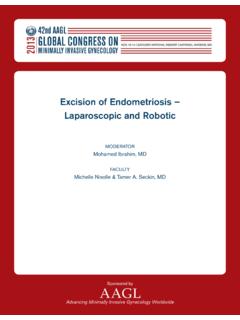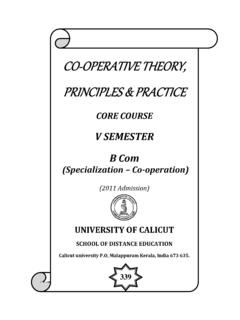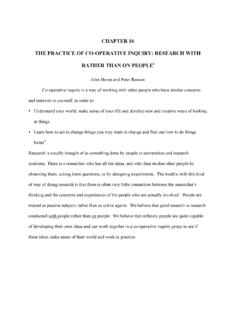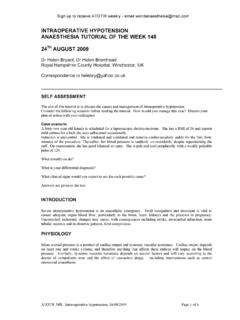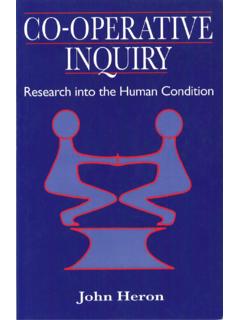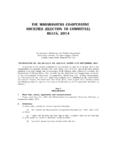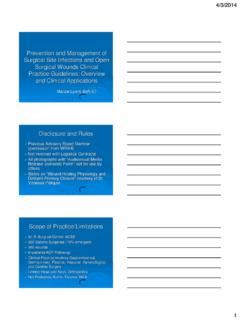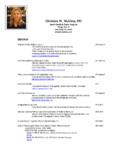Transcription of AAGL Practice Report: Practice Guidelines for the ...
1 Special Article aagl Practice report : Practice Guidelines for the Management of Hysteroscopic Distending Media (Replaces Hysteroscopic Fluid Monitoring Guidelines . J Am Assoc Gynecol Laparosc. 2000;7:167 168.). aagl ADVANCING MINIMALLY INVASIVE GYNECOLOGY WORLDWIDE. ABSTRACT The objective of this guideline is to provide clinicians with evidence-based information about commonly used and available hysteroscopic distending media to guide them in their performance of both diagnostic and operative hysteroscopy. While nec- essary for the performance of hysteroscopy and hysteroscopically-directed procedures, distending media, if absorbed system- ically in sufficient amounts, can have associated adverse events, including life-threatening complications. Consequently, understanding the physical properties and the potential risks associated with the use of the various distending media is critical for the safe performance of hysteroscopic procedures.
2 This report was developed under the direction of the Practice Commit- tee of the aagl as a service to their members and other practicing clinicians. Journal of Minimally Invasive Gynecology (2013) 20, 137 148 2013 aagl . All rights reserved. Keywords: Distending media; Electrolyte-free media; Fluid management system; Hypertonic; Hyponatremia; Hysteroscopy; Intravasation; Mannitol;. Ringer's lactate; Sorbitol; Uterine distention; Viscosity Use your Smartphone to scan this QR code DISCUSS You can discuss this article with its authors and with other aagl members at and connect to the discussion forum for this article now*. * Download a free QR Code scanner by searching for QR. scanner'' in your smartphone's app store or app marketplace. Definitions Used in this Guideline Hypotonic (or hypo-osmolar): Lower osmolality (con- centration of particles) than what is found in normal cells Osmolality: The concentration of osmotically active par- Resectoscope: An endoluminal surgical device compris- ticles in a solution ing an endoscope (hysteroscope or cystoscope), sheaths for Hypertonic: Higher osmolality (concentration of parti- inflow and outflow, and an element'' that interfaces a spe- cles) than what is found in normal cells cially designed electrode (or pair of electrodes) with a radio- Hyponatremia: Lower concentration of sodium than is frequency electrosurgical generator normally found in plasma Purpose and Scope The purpose of this guideline is to provide clinicians with evidence-based The objective of this guideline is to provide clinicians information about management of hysteroscopic distending media.
3 With evidence-based information about commonly used Single reprints of aagl Practice report are available for $ per report . and available hysteroscopic distending media to guide For quantity orders, please directly contact the publisher of The Journal of Minimally Invasive Gynecology, Elsevier, at them in their performance of both diagnostic and operative 2013 by the aagl Advancing Minimally Invasive GynecologyWorld- hysteroscopy. wide. All rights reserved. No part of this publication may be reproduced, stored in a retrieval system, posted on the Internet, or transmitted, in any Background form or by any means, electronic, mechanical, photocopying, recording, or otherwise, without prior written permission from the publisher. E-mail: Hysteroscopy is invaluable for diagnosing and treating intrauterine pathology. Hysteroscopic procedures are per- Submitted December 4, 2012. Accepted for publication December 5, 2012.
4 Formed using an endoscope, with or without an attached or Available at and integrated video imaging system, with intrauterine 1553-4650/$ - see front matter 2013 aagl . All rights reserved. 138 Journal of Minimally Invasive Gynecology, Vol 20, No 2, March/April 2013. distention accomplished with either gas (CO2) or fluid dis- Carbon Dioxide tending media. Because of the risk of embolism, most ex- perts consider that CO2 should be used exclusively for It is generally accepted that CO2 should be used as a dis- tending medium for diagnostic hysteroscopy only, as it is not diagnostic purposes, whereas fluid media can be used for suitable for operative hysteroscopy or diagnostic proce- both diagnostic and operative procedures. Fluid media can dures, in part because the concomitant blood and endome- be of low or high viscosity and of low or high molecular trial debris collect and obscure the optical field [1,2]. CO2.
5 Weight and can be either electrically conductive or noncon- is highly soluble in blood, and consequently, if modest ductive based upon the presence or absence of electrolytes in the fluid. While necessary for the performance of hystero- volumes of the gas reach the systemic circulation, the gas scopy and hysteroscopically directed procedures, distending is quickly absorbed and there is no relevant clinical impact [3]. However, if large volumes of CO2 reach the systemic cir- media, if absorbed systemically in sufficient amounts, can culation and the heart, catastrophic cardiorespiratory col- have associated adverse events including life-threatening lapse can occur [4]. Consequently, CO2 should be complications. Consequently, understanding the physical delivered to the endometrial cavity through the sheath of properties and the potential risks associated with the use of the hysteroscopic system from an insufflator designed spe- the various distending media is critical for the safe perfor- cifically for hysteroscopy, which regulates pressure and mance of hysteroscopic procedures.
6 Gas flow. The insufflator can be a separate unit or a small car- tridge attached via a handle of the hysteroscopic system. It is Identification and Assessment of Evidence essential that a low-pressure hysteroscopic insufflator be used and not a laparoscopic or other type of endoscopic in- This aagl Practice Guideline was produced after a sufflator, which typically inflate with much higher pressures. systematic review of the literature was performed through The use of such instruments for hysteroscopy could be asso- a search of the following electronic sources: Medline, ciated with death secondary to CO2 embolism [4]. PubMed, OVID, EMBASE, and the Cochrane Database CO2 may also have some disadvantages when compared of Systematic Reviews. MeSH keywords included hystero- with fluid media, even in diagnostic procedures. Two sepa- scopy,'' hysteroscopic risks,'' hysteroscopy complica- rate randomized controlled trials (RCTs) were designed to tions,'' hysteroscopy distending medium,'' hysteroscopy measure, among other outcomes, the patient's report of distending medium/media,'' uterine distension,'' distend- pain during and after the examination, the use of local anes- ing media/low viscosity,'' distending media/high viscos- thesia, observation of vasovagal reactions, patient satisfac- ity,'' distending media/gas'' and encompassed articles tion, and procedure time among women randomized to published from July 31, 1985, through July 31, 2011.
7 In to- receive distention with normal saline or with CO2 [1,2]. In tal, 3196 papers were identified, with 3137 determined not to the study by Brusco et al [1] (n 5 74), use of local anesthesia be relevant to the development of this guideline, leaving a to- was greater, and the group assigned CO2 reported higher tal of 59 that were utilized. procedure-related pain scores. Procedure times for the CO2. The full text of all publications deemed potentially rele- and the normal saline groups were 6 minutes vant was retrieved, abstracted and tabulated, and distributed and 6 minutes, respectively [1]. Pellicano et al for review by both the aagl Distending Media Guideline [2] found similar results in their multicenter study of 189 in- Development Committee and the members of the aagl . fertile patients. The normal saline group was observed to Practice Committee. Relevant publications were then re- have a lower incidence of vasovagal reactions, had overall viewed, and additional references were hand searched and shorter operative times, required less analgesics after the added if appropriate and as necessary.
8 All studies were as- procedure, and were more satisfied with the procedure. sessed for methodologic rigor and graded according to the These findings suggest that any advantages of CO2 are lim- US Preventive Services Task Force classification system. ited, but do not preclude its use in selected clinical situations outlined at the end of this document. Recommendations with appropriate equipment. were based on the best available evidence, where possible, and where such evidence was not available, upon consensus of the expert panel. High-Viscosity Distending Media High-viscosity media have the advantage of being immis- Media Types cible with blood, thereby facilitating evaluation of the endo- Distending media can be categorized as being either gas- metrial cavity in the presence of bleeding. The most eous or fluid, but the only gaseous medium in use is CO2. commonly used high-viscosity fluid for uterine distention Fluid distending media can be classified according to their is a hyperosmolar solution of 32% dextran 70 in 10% glu- osmolality, their electrolyte content, and their viscosity.
9 Tra- cose (Hyskon, Coopersurgical Inc., Trumbull, CT). The os- ditionally, viscosity has been used to group media types, but molality of Hyskon is such that 100 mL of the solution this categorization is becoming less useful with the declining administered intravenously can expand plasma volume by use of high-viscosity fluids. 870 mL [5], a circumstance that can result in vascular Special Article aagl Practice Guidelines for the Management of Hysteroscopic Distending Media 139. overload and subsequent heart failure and pulmonary edema When the urologic resectoscope was adapted for intra- [6,7]. Although the manufacturer has suggested that the uterine use, gynecologists initially assumed that the physiol- maximum volume of infused dextran should be 500 mL, ogy of absorption of distending solution in women, the osmolality and impact on plasma volume suggest that including those of reproductive age, would be the same as this should be considered a maximum and that volumes as that for males.
10 However, whereas hyponatremia occurs little as 300 mL may be associated with adverse outcomes with equal frequency in men and women, it became apparent [8,9]. that in such cases, premenopausal women are 25 times more Dextran 70 has also been associated with anaphylaxis, likely to die or have permanent brain damage than men or possibly related to prior sensitization to dextran from other postmenopausal women [15]. Collectively, these issues led sources. The incidence was determined to be 1:821 in a large to the need for careful evaluation of the mechanisms and im- study of 5745 patients who were given the agent intrave- pact of excess fluid absorption and the development of nously [10], and a number of case series have been reported means by which these risks could be mitigated and managed. in association with use at hysteroscopy [11 13]. Another issue related to the use of Hyskon is that it tends Types of Low-Viscosity Media to caramelize quickly on instruments, a feature that can lead The electrolyte-free low-viscosity media include 3% sor- to severe damage.



